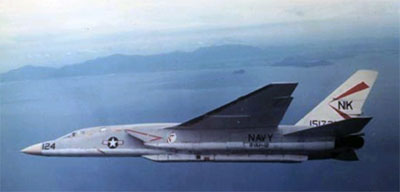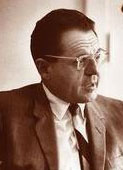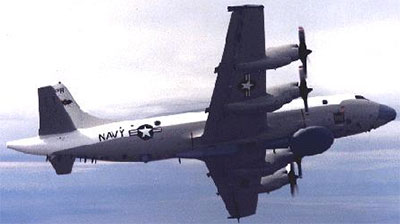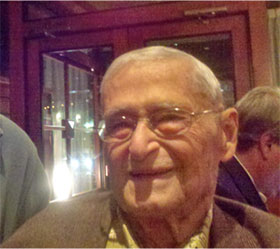
(An RVAH-12 RA-5C beginning its reconnaissance run over Vietnam, 1967. Photo USN).
Mac was waiting patiently at Willow, half way down the bar that Old Jim anchored at the Amen Corner. I was a little flustered. A subcontractor to us on a counterintelligence contract down at the Russel Knox Building at Quantico had some people working who got bored and staged an “unattended package” prank on a co-worker. When it was discovered, the building was evacuated- the whole thing, not just the people working on our little task order.
The end-of-day calls revealed that the Government was expecting to be reimbursed for the lost time of everyone in the building, and that I was generally responsible for all of it. This was going to be a mess for a couple weeks until we could unscramble everything. Sometimes I hate this business.
The cool darkness of Willow was a relief. I stopped to exchange greetings with Jim, who was content to sip his long-necked Bud and listen to old jazz on his MP3 player. I promised we would catch up after my chat with Mac. I walked down the bar and pulled out one of the stool and sat down after shaking his had. I started to gather the critical materials I needed to conduct the interview- a pen from my jacket pocket, a stack of cocktail napkins and my smart phone in case we needed information on the fly. I don’t know how people did histories before smart phones. Honestly.
Mac was dressed neatly in a sport jacket and tie. “We were talking about FIRST Fleet the other day. We were in the process of trying to make aerial reconnaissance reflect the changing nature of the Cold War. Advanced surface-to-air missiles were changing the equation for strike targeting purposes, and recce to assess the Bomb Damage Assessment. I was thinking about the RA-5C Vigilante program after we talked.”
“I remember the Viggie. We did not have them on Midway. Too big a jet for too small a flight deck. We had to use the Marine RF-4 Phantoms with camera capability. The RF-8 Crusaders were out of the Fleet by then.”
“I can give you some context on that. The RA-5C program was derived from the attack version of the jet, which was intended to be a supersonic deep penetration aircraft that would keep Navy in the nuclear strike business and not let the Zoomies claim that all strike warfare could be done by the Air Force.”
“I heard that didn’t work out that well. For survivability, the strikes were supposed to be a mach speed, and the weapon was deployed out the after end of the jet. Problem was that at speed the bomb would follow right along in the vortex.”
“You are correct on that, Vic. The Vigilante was built by North American in Columbus, Ohio. The program had its beginnings when I was in Y-1 and when Rufe Taylor, as a Captain, was head of the Intelligence Division of ONI. All of us were involved in the planning and structuring of the RA-5C program.”
“You were providing the requirements for recce, right, like for the satellites?”
Mac nodded. “We even made trips out to Columbus where it was being built, to work with the contractor. Of course, it was both a strike aircraft as well as a reconnaissance aircraft. We were concerned with the reconnaissance configuration; it was the RA-5C and had a canoe-like pod attached to the underbelly that would contain the sensors. The whole program, of course, was to have a platform that could be carried on a carrier, and launched to conduct its collection mission in a tactical environment and return to the carrier with the yards and yards of film from the canoe. It would be read out on light-tables right there in the Integrated Operational Intelligence Center. Not exactly near-real-time, but that was the best we could do for the crews that had to carry out the strike missions. Completely organic, and on the carrier. We did not have to wait for the Fleet Intelligence Center to turn it around to us. And remember, there was no imagery except hard copy.”
“I remember the Special Access package that FICPAC or the 548th RTG at Hickham would provide. It was the only satellite imagery we had for the cruise, unless something came up important enough to fly it out. We were literally cut off while we were at sea for most things.”
“Different world now, I imagine,” said Mac. “We never had anything fancy like that, and that was just the way it was.” He took a sip of his Virgin Mary. The Oncologists had him on the wagon again. I took a sip of Happy Hour white, swirling it on my tongue while thinking what version of the riot act I was going to read to the subcontractors who had played the prank. And made a note to talk to the lawyers at Corporate. “When I was in PACFLT after 1962, the RA-5Cs began deploying. I want to you to note this,” he gestured at my napkin, “because, on one occasion when I was N-2, my friend, Gene Fubini, who was then Director, Defense Research and Engineering (DDR&E) in the Pentagon, came out to Hawaii on a trip.”
“A boondoggle,” I said. “Seems we had a lot of Washington people come to Hawaii for critical meetings in January and February.”
Mac smiled. “Gene visited our headquarters for briefings, and, as I was seeing him off from the quarterdeck of the headquarters, the USS Constellation (CV-64), was moored right down at the foot of the Makalapa Hill at the Carrier Pier. Connie had an RA-5C sitting on its flight deck, clearly visible. Gene was a great advocate and supporter of the RA-5C program, and he looked down there, saw that aircraft and he said, “Mac, now that we have that aircraft deploying, we’ll be able to decommission the VQ squadrons.”

And I said, “Dr. Fubini, that will never, never happen.” He was convinced it would happen though,
and should happen, and I was convinced it wouldn’t because the two programs were so different in mission and capabilities. His concern as DDR&E was that a lot of research and development money had been put into the Vigilante system; it was new; it was a tactical support system; and I think he
felt genuinely there wouldn’t be a need for VQ collection after the RA-SC program was deployed.”

“He probably would have liked unmanned drones, too,” I said.
“Well, I’ll let history tell the rest of the story. The RA-SC program worked effectively for a few years, the VQs continued, the RA-SCs are now museum pieces, and the VQs still continue to fly.”
“They are going to replace them with a jet in a few years, but some of the EP-3 Oriens still flying were manufactured well before the Vigilante.”
“That’s right. As good an idea as the RA-SC and the IOIC program was, in the totality of naval intelligence, I think, it was just a passing fancy.”
“It had passed by the time I got to Midway in 1978. We worked in what was called the Carrier (CV) Intelligence Center- IC. The nickname was “CIVIC.” The Vietnam-era pilots still knew the IOIC by the nickname “101 Clowns.””
“The basic RA-5C airframe had problems that made it difficult to use as a bomber, and it took up so much room and was just so limited in its applications that it couldn’t continue to compete for space on the carriers. Plus, the things that it did, or was designed to do, were taken over by satellites so effectively, and in even better time– closer to real time — than what the RA-5C could do that it became superfluous.”
“I knew we all got confused. My F-4 Phantom squadron dated back to World War 2, and our call-sign was the “Vigilantes.”” I looked at Liz-S behind the bar hopefully. “We got confused with the recon guys all the time when the Cruise Boats would come out from the West Coast.”
“It can be a confusing business,” said Mac. “I am just glad to be here to put things straight.”

Copyright 2017 Vic Socotra
www.vicsocotra.com
